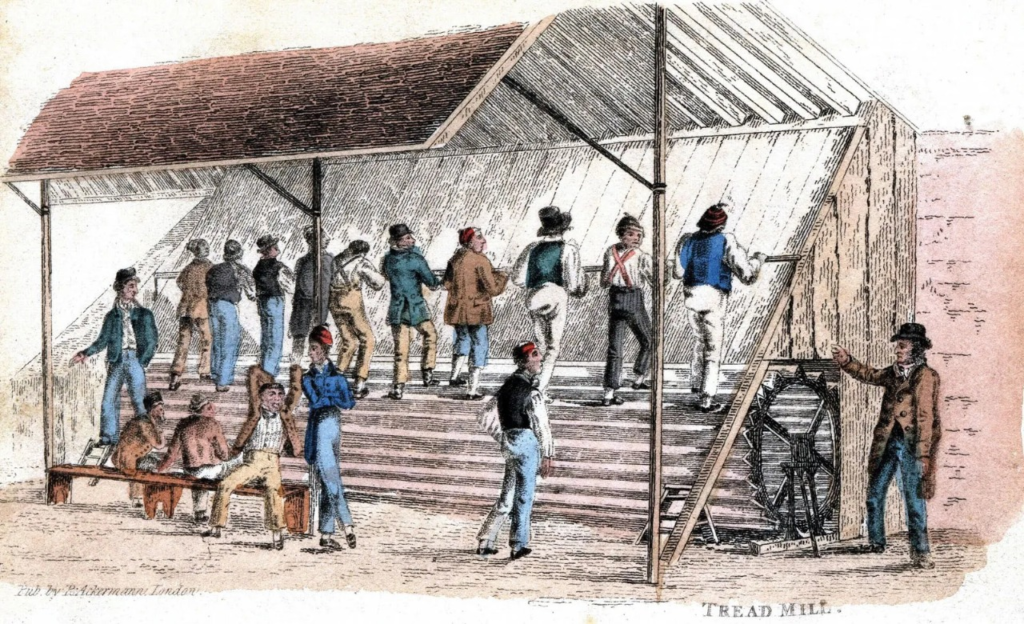
When we think of treadmills today, we imagine sleek, motorized machines that help us stay fit, run in place, or walk at home or the gym. However, the story behind this piece of exercise equipment is much more interesting than its modern-day use. The treadmill has undergone a remarkable transformation over the centuries, evolving from a tool of labor to one of the most popular fitness machines worldwide.
The Birth of the Treadmill: The Roman Treadwheel (1st Century AD)
The origins of the treadmill can be traced back to ancient Rome in the 1st century AD. Back then, it wasn’t about exercise or running for fitness; the “treadwheel”, a large, vertical wheel powered by human feet, was used as a labor tool. Prisoners or workers would walk on the wheel, and their movement was used to perform mechanical tasks like grinding grain or lifting heavy objects. This early version of the treadmill was intended to harness human energy to perform work, not for any form of exercise.

The Prison Treadmill: A Punitive Tool (19th Century)
The treadmill’s next significant development came during the 19th century. In 1818, Sir William Cubitt, an English engineer, invented the prison treadmill, a cruel form of punishment used in prisons. The device was a large, horizontal wheel that prisoners were forced to walk on, often for long hours, as part of their hard labor. The movement generated power to pump water or grind grain, benefiting the prison’s operations.
While the prison treadmill was designed as a form of punishment, it was also one of the first examples of a treadmill used to generate mechanical energy. Fortunately, its association with prison labor didn’t last long, but it marks a pivotal moment in the history of treadmills.
The Rise of the Exercise Treadmill (Mid-20th Century)
It wasn’t until the mid-20th century that the treadmill began to evolve into the exercise equipment we know today. The 1940s marked the advent of the exercise treadmill, particularly for medical purposes. In this era, treadmills were primarily used for cardiovascular testing, helping doctors assess the fitness of patients. The Bruce Protocol, created by Dr. Robert Bruce in the 1950s, became a popular treadmill test to monitor heart health by gradually increasing the intensity of exercise.
Treadmills for Home Use: A Fitness Revolution (1960s)
While treadmills were initially used for medical purposes, the 1960s saw a shift toward personal fitness. Influential exercise physiologist Dr. Kenneth Cooper helped popularize aerobic exercise, and soon, people began using treadmills to get in shape at home.
The next major innovation came in 1968, when William Staub designed the first motorized treadmill for home use. Staub’s simple yet effective design made it easier for people to walk or run indoors, even during inclement weather. His invention was a game-changer, making fitness more accessible to a wider audience.
Staub’s company, HealthRite, introduced the first commercial motorized treadmill, which allowed the belt to move automatically, sparing users the effort of walking or running on a manual device. This breakthrough laid the foundation for the modern treadmill that many of us use today.
Modern-Day Treadmills: Technology Meets Fitness
Treadmills have come a long way since the days of labor and punishment. Today’s treadmills are marvels of technology and engineering. They feature advanced digital displays that track your speed, distance, time, and even heart rate. Many modern machines allow you to adjust the incline, adding variety to your workouts, and providing a more challenging experience.
Today, treadmills come equipped with features like:
- Pre-programmed workout routines for different fitness levels.
- Advanced cushioning systems that reduce joint impact.
- Connectivity with fitness apps to track and share progress.
- Foldable designs that make storage easier in homes or gyms.
- Entertainment options like built-in screens for streaming videos or following virtual running tracks.
- The evolution of treadmills has made them one of the most popular exercise machines in homes and gyms around the world. From their humble beginnings as tools for manual labor to their current status as high-tech fitness machines, treadmills have undoubtedly become an essential part of modern fitness routines.
Conclusion
The journey of the treadmill is a testament to human ingenuity and the changing needs of society. What began as a machine to harness human power for work and punishment has transformed into a versatile tool for improving health and fitness. Today, treadmills not only help us get in shape but also remind us of the long history of innovation that led to their development. Whether you’re walking, running, or jogging, you’re now part of a story that spans thousands of years!